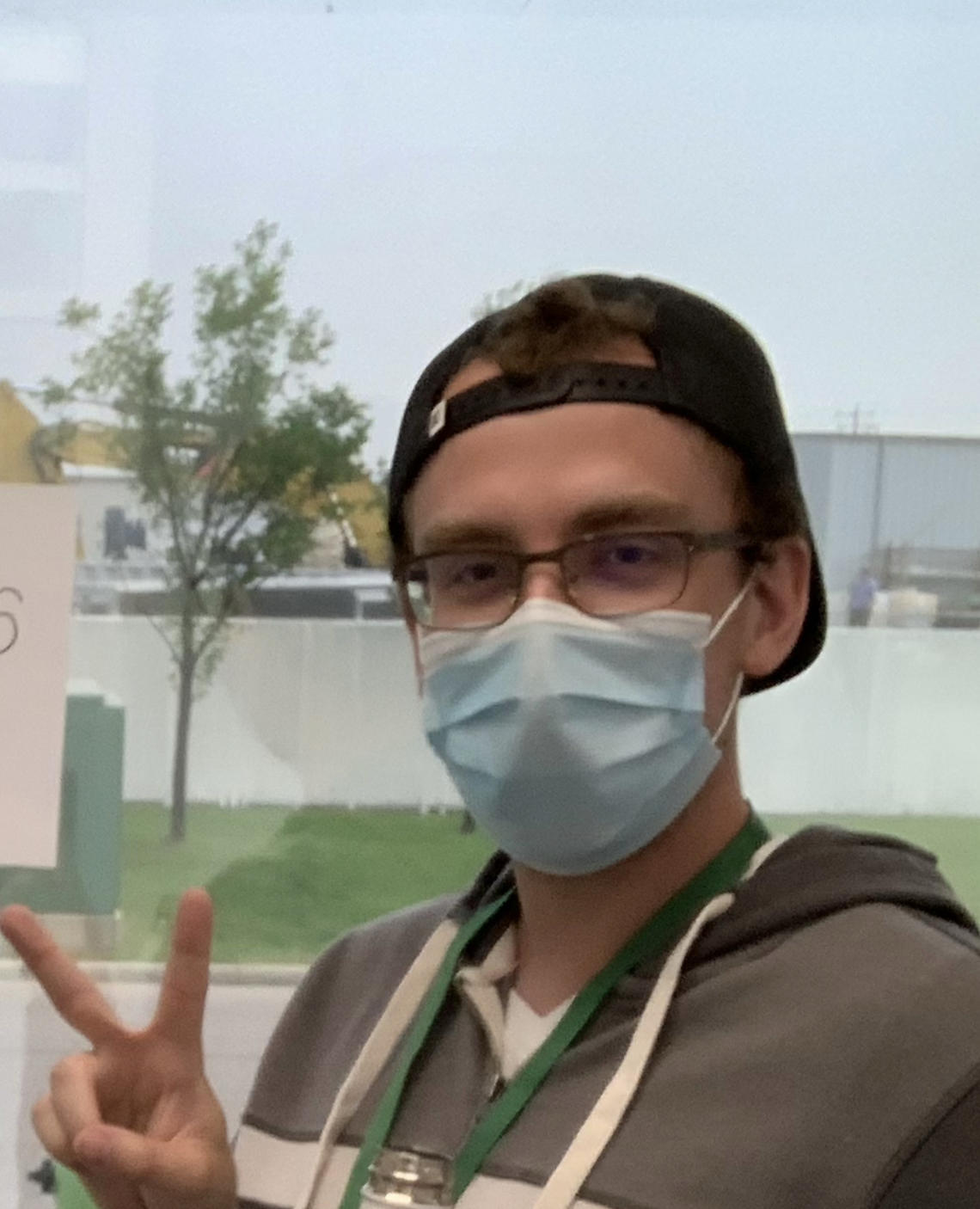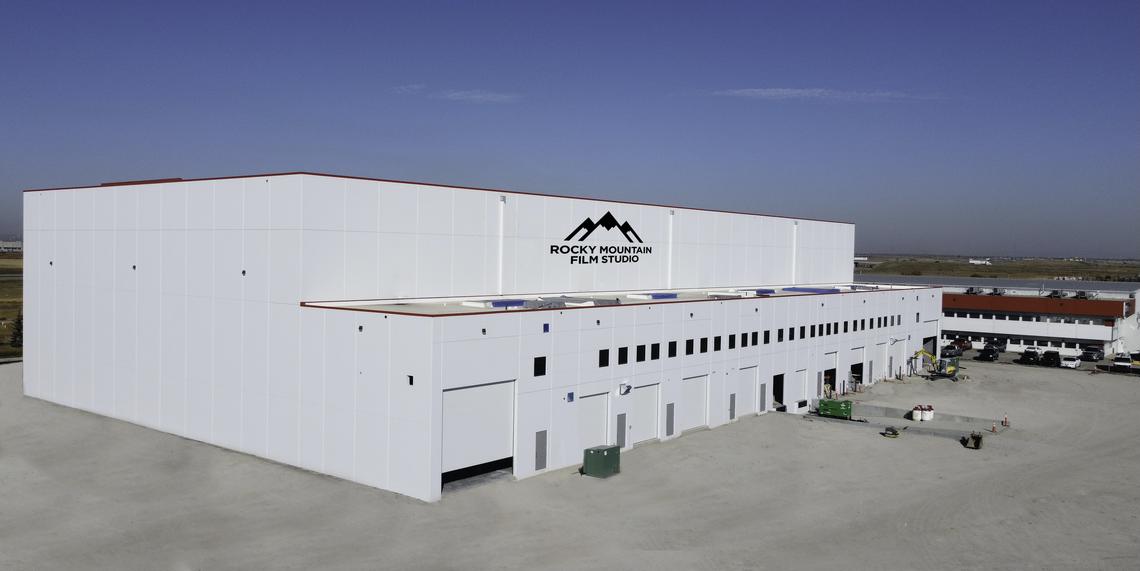Oct. 25, 2022
Lights! Camera! Action! in Alberta like never before

It’s not every day you get to stand in . . . the future. But here, on the scruffy skirts of southeast Calgary, is exactly where we are. And it’s big. Dusty. Loud. And extraordinary.
Between nondescript industrial parks and hollow warehouses, the future footprint of Calgary’s film industry is being blasted into place right now at Rocky Mountain Film Studios (RMFS). And it’s mindblowingly massive.
Two 21,000-square-foot purpose-built stages are on the books, to be semi-operable by November. The skeleton of a 70,000-sq. ft. support building — for wardrobe, mill work, set-deck storage — is up and slated to open in March 2023. And sometime in between those milestones, circus parking will be available for the trucks, equipment, gear and lifts to enter with ease.
The scope and magnitude of RMFS (which also has a south campus, eight kilometres from here at HQ) is unimaginable, until Scott Evans, a 36-year veteran of Vancouver’s film industry, and executive VP of RMFS, takes you on a tour.

Mayor Jyoti Gondek recently went to L.A. where she helped pitch Alberta’s film future to Hollywood studio executives.
Indeed, this is part of the same tour he helped orchestrate when prepping Mayor Jyoti Gondek, MA’03, PhD’14, for a September 2022 trade mission to Los Angeles where she helped pitch Alberta’s film future to Hollywood studio executives.
Her impact was palpable, adds Erin O’Connor, business development manager for the Calgary Film Centre, who, like Evans, was part of the delegation. “We were getting phone calls from interested parties by Day 2,” she says.
Prepping for the trade mission entailed a 10-hour tour of Calgary’s biggest film studios (Calgary Film Centre, RMFS and yet another facility, William F. White), visits to three ranches (boasting western-town sets), and umpteen meetups with equipment and technical crews. By then, Gondek had formed and nailed her two key messages:
“What I said was . . . ‘We know we need to reach a critical mass and we know that collaborating will get us there. And the film and TV industry can save our ranch lands from development . . . so land conservation was another theme we stressed,’” says Gondek.
Collaboration and conservation were, quite simply, what Gondek witnessed on her pre-trip prep tour.

Scott Evans in front of the two 21,000-sq.ft. purpose-built stages that should be semi-operable by November.
When a city says YES!
“Not many major cities would close down a vital artery like Calgary did when we shut down the 4th Avenue flyover for The Last of Us,” recalls Gondek proudly.
“We have been so beaten down by the economic recession that Calgarians are willing to give a bit to boost our economy again. No one had a meltdown and, frankly, I think most of us were excited to see film activity going on as the concept is still fresh [in Calgary], where it may not be in Toronto or Vancouver.”
In fact, film production in Calgary today is on par with Vancouver in the 1980s, as it was entering its heyday as a film- and TV-production hub, says Evans, who divides his time between Calgary and Vancouver.
“Here, people are friendly, helpful, eager to see things work,” he says. “What you can do in Calgary is now impossible in Vancouver. Shutting down streets to the downtown core is not easy in many cities . . . anywhere.”
But in Calgary, streets and other parts of Inglewood and downtown were transformed for HBO’s adaptation of the epic video game, The Last of Us, about a man and a young girl’s quest to survive a cross-country trek across post-apocalyptic America. The production even took advantage of the Northland Village Mall in the northwest being closed ahead of redevelopment in late 2021 to tell their story.
What catalyzed the change in Alberta’s and Calgary’s film industry, doubling the production value from 2019 to 2021, was lifting a pernicious per-production cap. In 2021, the Alberta government eliminated the $10-million cap (set amount) that a production can receive, explains local producer, Matt Watterworth, who worked on Heartland for five years.
The moment that announcement was made, the hose was immediately turned on, recalls O’Connor. “The $10-million cap had meant we were only viable for projects up to $30 million, which prevented us from being globally competitive or getting any major projects,” she says. “Lifting the cap and guaranteeing a tax-credit refund has made all the difference.”
Soon after the announcement, HBO signed on for the filming of Canada’s most expensive TV production ever, the $150-million, 10-episode The Last of Us (watch the latest trailer). Shooting not only in Calgary, but also in High River, Canmore, Grande Prairie and Edmonton, the 13-month project employed thousands of people — from extras to crews of equipment, technical and production experts — said International Alliance of Theatrical Stage Employees Local 212 President Damian Petti at a recent industry panel at the Calgary International Film Festival (CIFF).
"These are very good jobs, they help our economy, and they also increase southern Alberta’s standing within the global marketplace," Petti said.

Recent grad Mason Purnell worked on The Last of Us.
No one agrees with that more than UCalgary poli-sci major, Mason Purnell, BA’19, who graduated with a minor in film studies. His one-week hire as a production assistant (PA) on The Last of Us quickly became an 11-month full-time gig that had him doing everything from chatting with the series’ writer-producer, Craig Mazin, to stopping traffic, grabbing coffee for the crew, even setting up tents.
“You learn a little bit of everything,” says the 29-year-old, who is about to start work as a PA for the Calgary-filmed revival of the Jim Henson classic series, Fraggle Rock. “Once you’re in, you’re sort of in!”
With dreams of being a producer within a decade, Purnell is thrilled that his first foray into this industry netted him work on something like The Last of Us, but he cautiously adds he hopes the film industry doesn’t mirror the boom-and-bust cycle of that other major Alberta industry — oil and gas.
Labour pains
“I do believe we could rival Vancouver and Toronto in 10 years’ time if we can overcome a few obstacles,” Purnell says, citing the need for more post-production facilities such as editing suites, sound stages, digital effects centres, writers’ rooms and more purpose-built studios such as the Calgary Film Centre.
Precisely what the RMFS is addressing by constructing two new 21,000 sq. ft purpose-built stages as well as retrofitting five older warehouses.
But there is more to film and TV production than huge studio facilities and mega-productions. Watterworth hopes big-budget productions don’t muscle out smaller local producers and crews. Besides investing in infrastructure, Watterworth would like to see “stronger advocacy organizations speak for Albertan producers to government,” as well as a “more expanded version of the Alberta-Made Production Grant for local producers, more structured training programs for behind-the-scenes crews,” although “working alongside big productions such as The Last of Us or Ghostbusters [Afterlife] can give us knowledge and skills from the best in the world . . . that is invaluable for local producers. But we have to keep the momentum going, or the talent and work will leave Alberta.”

Assistant prof Jamie Rothenburger of UCalgary Vet Med is featured in the recently released documentary Living Without Menace, available on CBC Gem.
Sarah Koury
The very nature of the film industry is a volatile one, with crews typically moving where the work is. “Vancouver didn’t have everything in place when they first started,” explains Evans, “and now there can be 50 to 70 productions happening at one time (Calgary is busy with five or six). We all want to stay here and support local and we are making strides and quickly. With a better infrastructure, the volume will grow.”
“The mayor is doing what we all have to do . . . tell the story of Alberta better than we have,” adds Mary Arnatt, BA’16, MA'18, who is working on her PhD in production and media studies at York University. “We need to tell the world about our summers, our long days, our film studios, our diverse economy, our film festivals. They need to know.”
Mentors provide new skills and access
Those who recently attended CIFF or watch CBC Gem may have seen Ted Stenson’s latest works — Foul (a six-minute short about anger in sport that played at CIFF) and Living without Menace (a 60-minute quirky documentary about Alberta’s 70-year-old rat-free status that aired on CBC Gem in late September 2022).
Like others, Stenson, BA’72, worries about the volatile nature of this industry, but agrees with Evans that infrastructure improvements will “certainly make the sector more sustainable and even the playing field so we can compete with Vancouver and Toronto.”
Stenson, however, maintains there’s a shortage of training opportunities for crew members. Although the Directors Guild of Canada, various unions (such as IATSE), and the Film Centre offer workshops and courses, Stenson, Watterworth, Purnell and others say more is needed.
On Stenson’s documentary shoot, he used part of his Canada Council grant to bring in a top cinematographer from Toronto whom “we all got to work with, which was so worth it. The film looks awesome, and our crew really benefited from not only his knowledge but his connections within the industry, which had us working with high-level gear that normally we wouldn’t have access to.”
Accessibility to Alberta’s film industry is precisely what drives film major Katie Wackett, BA’17. Besides teaching a filmmaking program at the National accessArts Centre (Canada’s oldest and largest disability arts organization), Wackett also works at the Calgary Underground Film Festival (Nov. 23 to 27) as the box office co-ordinator.
The biggest game-changers, she says, have been the shift in tax credits, the lift in per-production caps, and the arrival of the Film Centre, but, “audience members could support our local productions and talent more than they do. Most people still want big, mainstream Hollywood productions, and there is so much more.
“With the industry becoming more economically stable and an infrastructure that continues to improve, I’d like to think that our local filmmakers will have more of a chance to share their voices and perspectives and, in 10 years, let’s hope there is far more diversity than today. Let’s help them find a path for future projects, too.”
If you ask Evans, there will be room and space for everyone in Alberta from Hollywood bigwigs to emerging low-budget producers.
“No doubt about it,” he says, surveying the future of RMFS. “This is the most exciting project I’ve ever done. This is right off the rails. We are cutting no corners in the design of these studios as the Simonelli family (one of the key partners and investors behind RMFS) want the best. Having everything at one location is something Calgary has never had before . . . it will be a game-changer.”
How you can get involved in this exciting industry
Interested in increasing your knowledge about film? Take a course in film literacy, volunteer at a festival, boost your credentials, become an attentive cinephile . . . here’s where to start:
- How to get into the Film Industry
- Calgary Society of Independent Filmmakers
- Electronic Media Arts Centre
- Calgary International Film Festival (CIFF)
- Calgary Underground Film Festival
- Fairy Tales Queer Film Festival
- Quickdraw Animation Society
- Calgary Cinematheque
- Calgary Justice Film Festival
- Calgary European Film Festival
- FascinAsian Film Festival
- Calgary Black Film Festival
- National accessArts Centre

Two new soon-to-open state-of-the-art stages at Rocky Mountain Film Studios.






